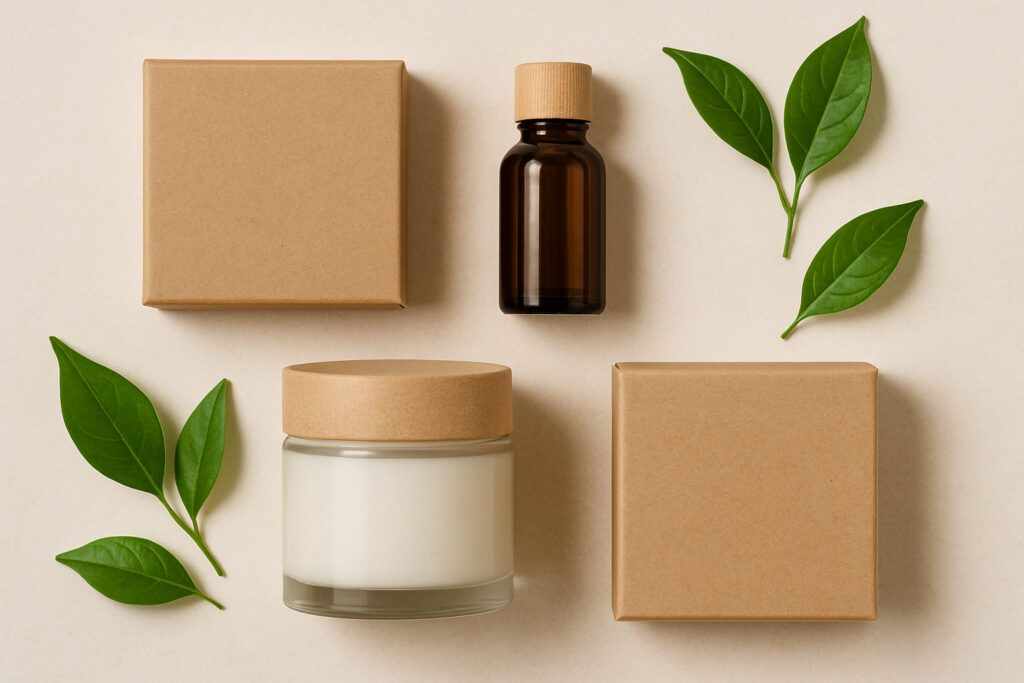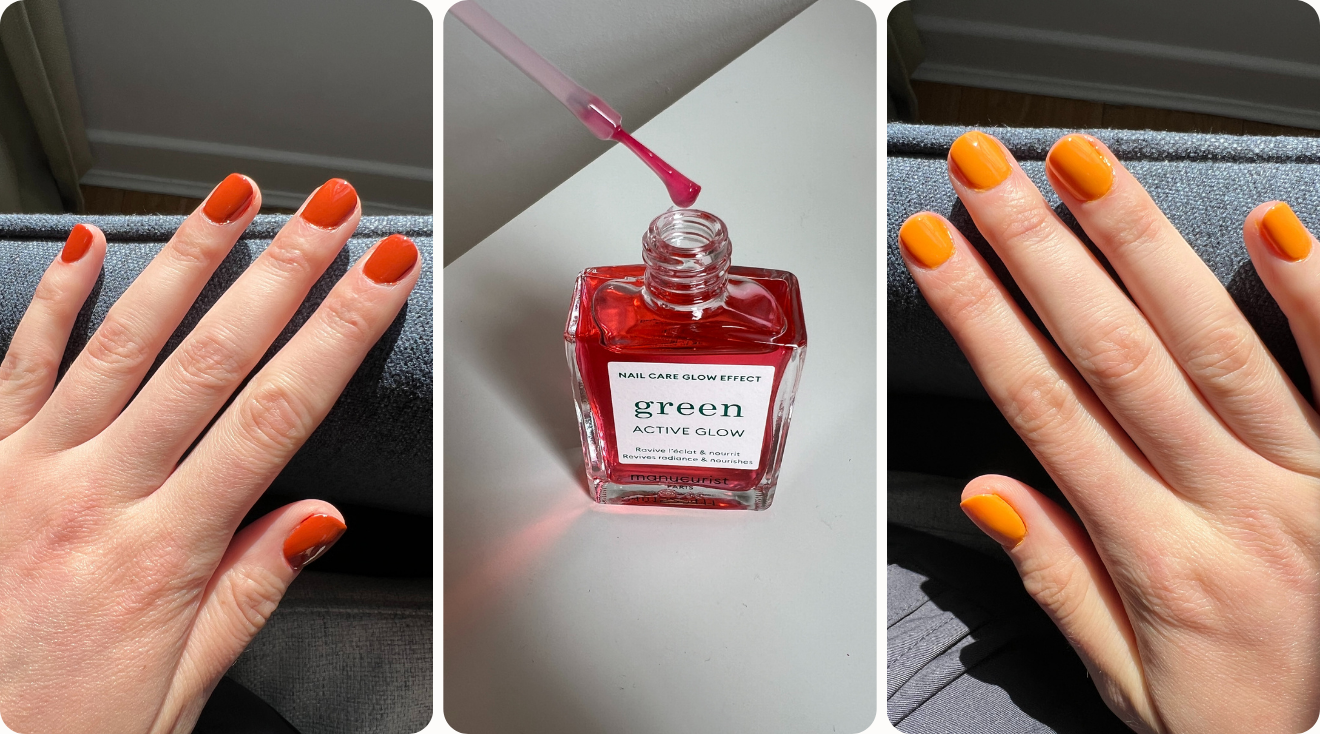Why Sustainable Beauty Is the Future of Skincare
Sustainable skincare is changing how we think about beauty by prioritizing both skin health and environmental responsibility through clean ingredients, eco-friendly packaging, and ethical sourcing practices.
Quick Guide to Sustainable Skincare:
- Clean Formulations: Products free from harmful chemicals like parabens, sulfates, and synthetic fragrances
- Eco-Friendly Packaging: Refillable containers, biodegradable materials, and post-consumer recycled plastics
- Ethical Sourcing: Fair trade ingredients, regenerative agriculture, and transparent supply chains
- Minimal Waste: Concentrated formulas, solid bars, and multipurpose products that reduce packaging
- Certifications to Look For: COSMOS, ECOCERT, Leaping Bunny, and Climate Neutral verified brands
The beauty industry produces a staggering 100 billion units of plastic packaging annually, with over 90% ending up in landfills. Meanwhile, consumer demand is driving real change – over 40% of shoppers now prioritize natural components in their beauty products, and the natural cosmetics ingredients market is projected to grow from $642 million in 2022 to $1,095 million by 2030.
This shift isn’t just about feeling good about your purchases. It’s about recognizing that what we put on our skin affects both our health and the planet’s wellbeing. From waterless formulations that reduce shipping emissions to refillable systems that cut packaging waste by 99%, sustainable skincare offers practical solutions without compromising on results.
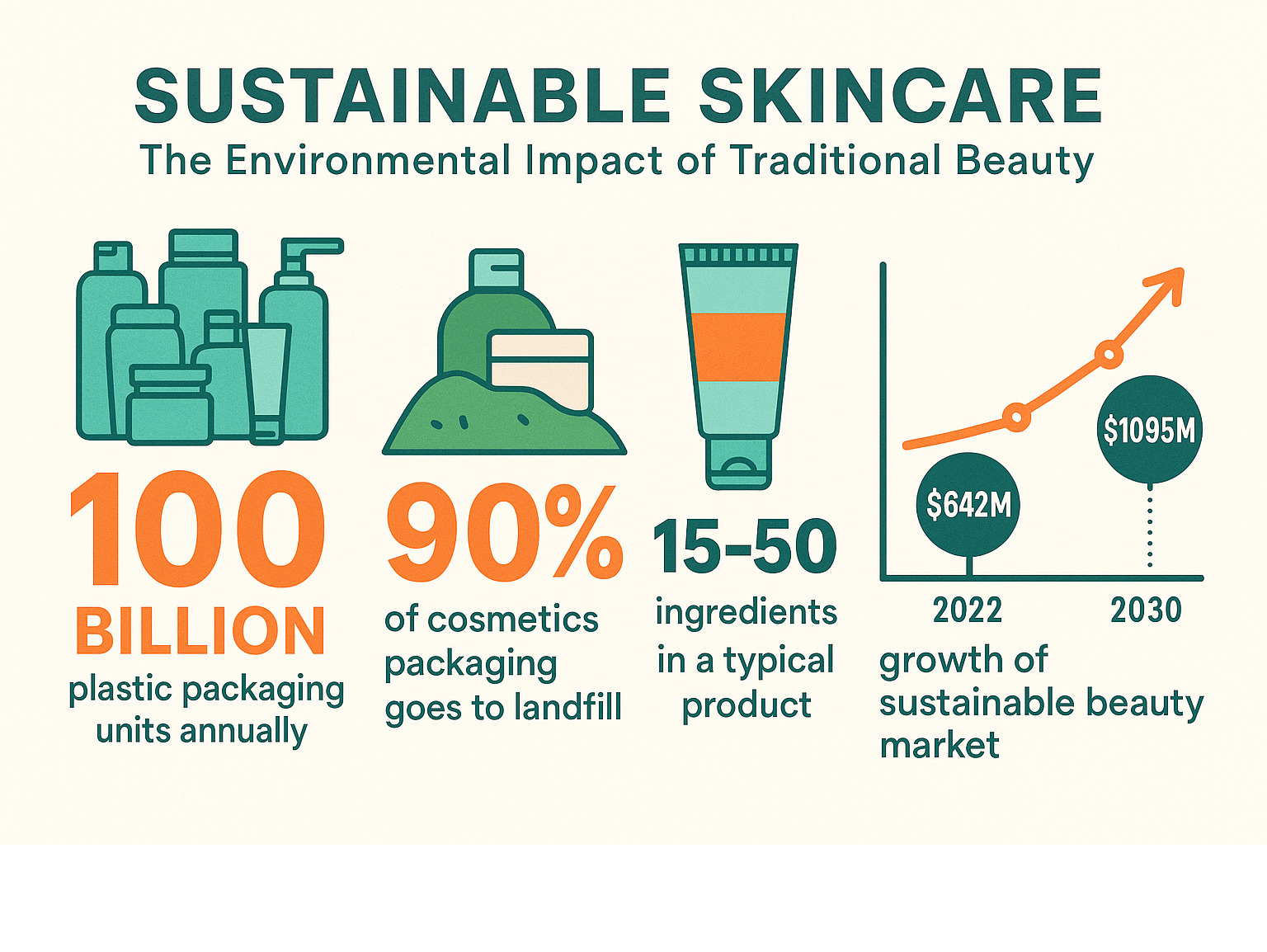
Sustainable skincare terms simplified:
Why Sustainability in Skincare Is Non-Negotiable
The beauty industry has reached a turning point where caring for our planet isn’t just nice to have – it’s absolutely essential. Every day, our skincare choices create ripple effects that extend far beyond our bathroom counters, touching everything from ocean health to climate change.
Think about it: when you squeeze that plastic tube of cleanser, you’re part of a system that produces 100 billion units of packaging every single year. Most of that plastic? It’s heading straight to landfills, where it’ll sit for centuries. But here’s the thing – more and more people are waking up to this reality and demanding better.
The shift toward sustainable skincare isn’t happening in isolation. According to latest research on market growth, we’re witnessing a complete change in how beauty products are made, packaged, and sold. This change reflects something deeper: people – especially younger generations – are making purchasing decisions based on their values, not just product promises.
The result? Even the biggest beauty companies are scrambling to reformulate products, increase transparency about ingredients, and invest in packaging that won’t harm our planet. As we explore eco-friendly beauty routines, it becomes crystal clear that sustainability isn’t a passing trend – it’s becoming the baseline expectation for responsible beauty.
Environmental & Social Impacts
Let’s talk numbers, because they’re pretty eye-opening. The beauty industry churns out approximately 100 billion units of plastic packaging annually. To put that in perspective, the US alone accounts for 11.4 billion units as of 2023. That’s a lot of plastic tubes, bottles, and containers that most of us toss without a second thought.
But the environmental impact goes way deeper than packaging. Many skincare ingredients come with their own environmental costs – deforestation for palm oil derivatives, massive water usage for botanical extracts, and greenhouse gases from shipping ingredients around the globe. Your average skincare product contains 15 to 50 ingredients, each with its own environmental story.
The human side of this equation matters just as much. Fair labor practices ensure that the people growing and harvesting our skincare ingredients can support their families and communities. When brands invest in ethical sourcing, they’re not just checking a box – they’re creating real positive change in places where ingredients are grown and processed.
Here’s something that might surprise you: the way products are made can dramatically impact their environmental footprint. Traditional manufacturing methods often require lots of energy for heating and mixing, while newer techniques can cut energy use by more than 80%. It’s proof that innovation and sustainability can work hand in hand.
Key Metrics Driving Change
The numbers behind the sustainable beauty movement tell a fascinating story. More than 40% of shoppers now actively look for natural ingredients in their beauty products. That’s not a small niche – that’s nearly half of all consumers voting with their wallets for cleaner, greener options.
This consumer demand is translating into serious market growth. Natural emollients – those ingredients that keep your skin soft and smooth – are expected to grow at a CAGR of 5.5% through 2030. These plant-based alternatives are replacing petroleum-derived ingredients like mineral oil, and people are loving the switch.
But here’s the statistic that should make us all pause: 90% of cosmetics packaging currently ends up in landfills. That’s an enormous waste problem that’s crying out for solutions. The good news? Refillable packaging systems can reduce CO2 emissions by 99% and plastic waste by 75% compared to traditional packaging.
These metrics aren’t just interesting data points – they represent a fundamental shift in how we define success in beauty. Brands are increasingly being judged not just on whether their products work, but on whether they’re helping or harming our planet in the process.
Meet the Sustainable Skincare Heroes
Our curated selection of sustainable skincare products represents the best of what’s possible when innovation meets environmental responsibility. These products showcase cutting-edge approaches to formulation and packaging, from refillable systems that dramatically reduce waste to solid formats that eliminate water and preserve actives. Each product demonstrates how waterless serums, multipurpose balms, and biodegradable capsules can deliver exceptional results while supporting cruelty-free testing and ethical sourcing practices.
The beauty of these sustainable heroes lies in their multifunctional approach. Rather than cluttering your routine with single-purpose products, these formulations are designed to streamline your regimen while maximizing both efficacy and environmental benefits. They represent a shift toward conscious consumption – choosing fewer, better products that serve multiple purposes and minimize packaging waste.
Refillable Gel Cleanser
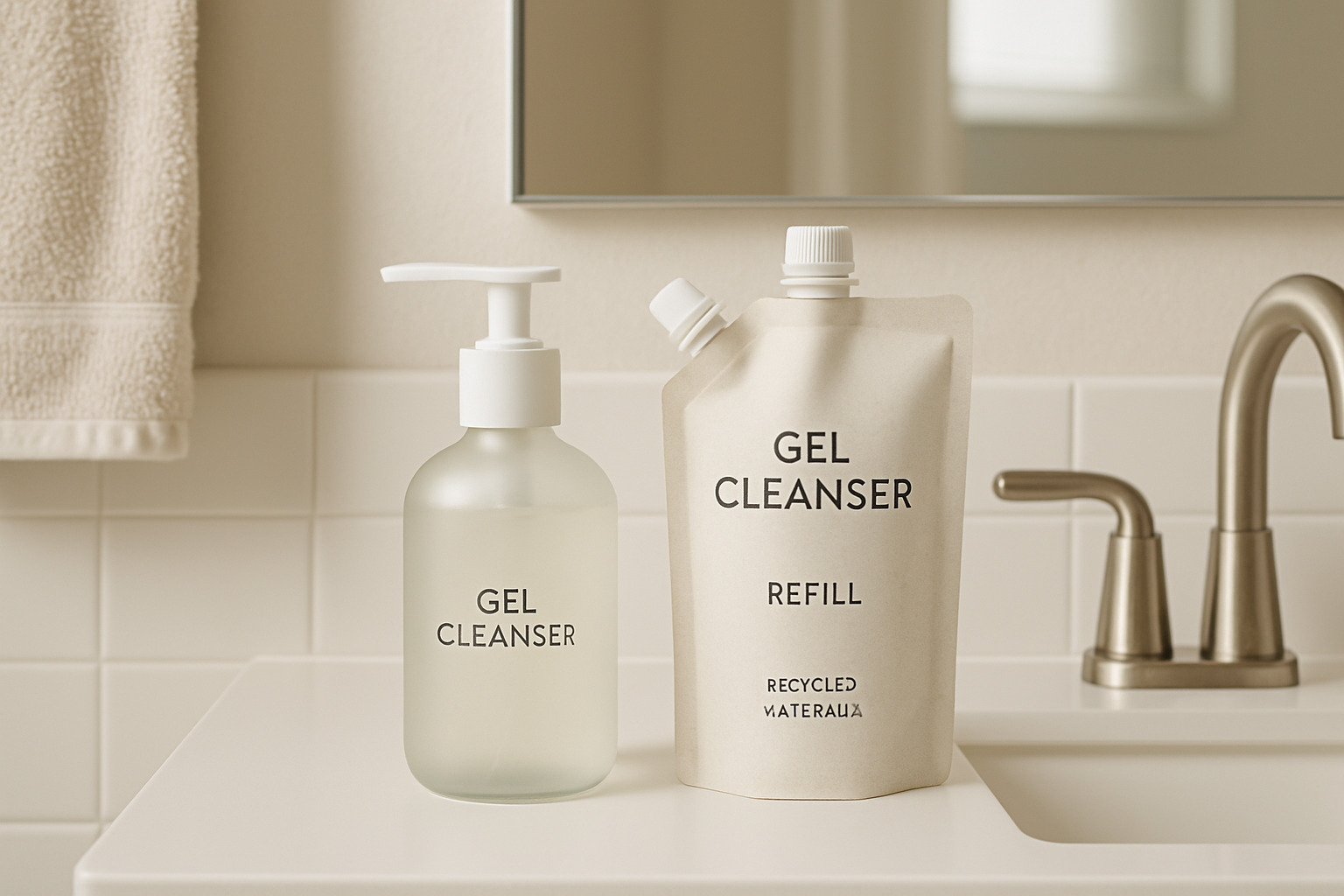
The refillable gel cleanser represents a breakthrough in sustainable packaging design. These systems typically use refill pouches that generate 99% less CO2 and 75% less plastic waste compared to traditional bottles. The gentle surfactants are derived from coconut and other plant sources, avoiding harsh sulfates that can strip the skin’s natural barrier.
What makes these cleansers special is their pH-balanced formulation, typically ranging from 5.5 to 6.5 to match your skin’s natural acidity. This careful balance helps maintain the skin microbiome while effectively removing impurities and makeup. The refill pouches are often made from post-consumer recycled materials and can be recycled again after use.
The gel texture provides a luxurious cleansing experience without the environmental cost of traditional packaging. Many formulations incorporate botanical extracts like chamomile or green tea for their antioxidant properties, while avoiding synthetic fragrances that can trigger sensitivities.
Solid Cleansing Bar
Waterless formulations like solid cleansing bars eliminate the need for preservatives while concentrating active ingredients. These bars typically come in compostable packaging made from recycled cardboard or seed paper, creating zero waste at the end of their lifecycle. The travel-friendly format means no TSA restrictions and no risk of spills in your luggage.
The formulation science behind solid bars is fascinating. Without water, there’s no need for synthetic preservatives like phenoxyethanol or parabens. Instead, the natural pH of the soap base and the absence of water create an environment where harmful bacteria cannot thrive. This results in a product that’s both gentler on skin and more stable over time.
Modern solid cleansers avoid the harsh alkalinity of traditional soap by using gentle cleansing agents and pH-adjusting ingredients. Many incorporate nourishing oils like coconut, olive, or shea butter to prevent the tight, dry feeling associated with conventional bar soaps. The result is a cleanser that’s both effective and moisturizing, with zero microplastics entering waterways.
Concentrated Powder Exfoliant
Preservative-free powder exfoliants represent the pinnacle of minimal water use in skincare. These concentrated formulations activate when mixed with water, creating a fresh exfoliating treatment without the need for synthetic preservatives. The recyclable tin packaging eliminates plastic waste while protecting the powder from moisture and contamination.
Enzymatic actives like papain from papaya or bromelain from pineapple provide gentle chemical exfoliation without harsh scrubbing particles. These natural enzymes break down dead skin cells more effectively than physical scrubs while being gentler on sensitive skin. The powder format allows for customizable strength – use less water for a gentler treatment or more for deeper exfoliation.
The concentrated nature means a small amount goes a long way, reducing packaging size and shipping emissions. Many formulations include additional actives like vitamin C powder or alpha-hydroxy acids that remain stable in the dry environment but activate upon contact with water.
Multipurpose Facial Oil
Cold-pressed botanical oils represent the ultimate in sustainable simplicity. These single-ingredient or minimal-blend formulations harness the natural power of omega fatty acids, vitamins, and antioxidants without any synthetic additives. The glass dropper bottles can be reused indefinitely, and many brands offer refill services to minimize packaging waste.
The DIY simplicity of facial oils makes them perfect for those seeking transparent, uncomplicated skincare. Oils like hemp seed oil contain an ideal ratio of omega-3, omega-6, and omega-9 fatty acids that mirror the skin’s natural sebum composition. This makes them suitable for all skin types, including acne-prone skin that may benefit from the balancing effects of linoleic acid.
Cold-pressing preserves the integrity of heat-sensitive compounds like vitamin E and essential fatty acids. This traditional extraction method requires no chemical solvents and produces oils with superior stability and therapeutic properties. The result is a multipurpose product that can serve as a cleanser, moisturizer, treatment serum, and even hair conditioner.
Biodegradable Capsule Serum
Plant-based capsule technology represents an innovative approach to sustainable packaging and product preservation. These biodegradable shells, often made from seaweed or other marine plants, provide airtight freshness while eliminating plastic waste. The precise dosing ensures no product waste while maintaining the potency of active ingredients.
The capsule format protects sensitive ingredients like vitamin C, retinol, and peptides from light and air exposure, which can degrade their effectiveness. Each capsule contains exactly the right amount for one application, eliminating guesswork and preventing contamination of the remaining product. This precision dosing is particularly important for expensive active ingredients.
The plant-based shells dissolve completely when rubbed between your fingers, releasing the concentrated serum without leaving any residue. Many formulations combine water-soluble and oil-soluble actives in a single capsule, creating complex treatments that would be impossible to stabilize in traditional liquid formats.
Smarter Packaging & Ingredient Science
The real magic happens when brilliant minds reimagine how we package and formulate sustainable skincare. We’re witnessing a complete change where circular design principles are becoming the norm rather than the exception. Post-consumer resin is quickly replacing virgin plastic in packaging, while breakthrough technologies like Natural Deep Eutectic Solvents (NaDES) are revolutionizing how we extract the best from botanical ingredients.
Think of NaDES as nature’s own extraction method – these remarkable solvents can pull up to 97% of beneficial compounds from plants while remaining completely biodegradable. The scientific research on NaDES innovation shows just how game-changing this technology is for creating potent, eco-friendly formulations.
Green chemistry is changing ingredient production through clever biological processes. Instead of relying on petrochemicals, brands are using fermentation and microbial cell factories to create identical ingredients through sustainable methods. It’s like brewing beer, but instead of alcohol, you’re creating skincare actives that would traditionally come from fossil fuels.
The upcycling movement is turning yesterday’s waste into tomorrow’s skincare heroes. Coffee grounds become gentle exfoliants, grape seeds transform into powerful antioxidants, and fruit peels reveal their hidden potential as brightening agents. This approach tackles two problems at once – reducing agricultural waste while creating effective skincare ingredients.
Packaging innovation is moving beyond recycling toward complete biodegradability. Seaweed-based films, mushroom packaging, and even edible containers are no longer science fiction. These materials break down completely in your home compost, leaving absolutely no trace behind. Many plastic-free skincare brands are leading this charge, proving that effective skincare doesn’t need plastic packaging.
Emerging Innovations
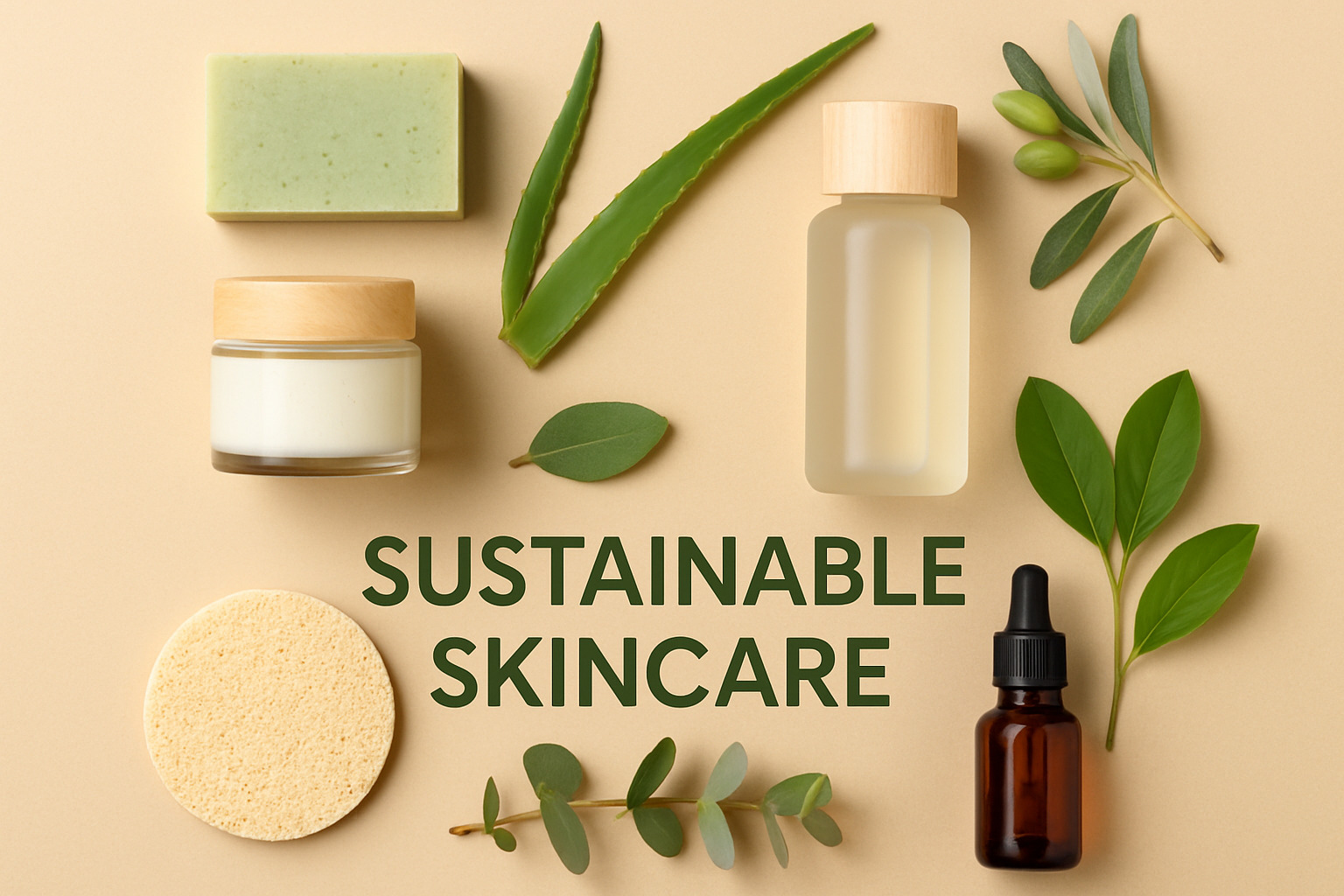
Rhamnolipid biosurfactants are changing the cleansing game entirely. These bacterial-produced compounds clean better than synthetic alternatives while actually feeding aquatic ecosystems as they break down. It’s like having a cleanser that improves the environment rather than harming it.
Sugarcane squalane has completely replaced the need for shark-derived ingredients without any compromise in performance. The molecular structure is identical, but the source is renewable and cruelty-free. The fermentation process that creates this plant-based alternative can scale globally without environmental impact.
Cold-process emulsions are revolutionizing manufacturing by eliminating the massive energy requirements of traditional heating methods. These techniques slash energy consumption by over 80% while often creating better textures and preserving delicate botanical actives that heat would destroy. It’s smarter chemistry that benefits both your skin and the planet.
Refill stations are starting to pop up in progressive retailers, allowing you to bring your own containers for bulk skincare products. This eliminates packaging entirely while saving you money. The precise dispensing systems ensure you get exactly what you need without contamination concerns – it’s like having a skincare fountain that never runs dry.
Crafting Your Own Low-Impact Routine
Building a sustainable skincare routine doesn’t mean overhauling everything overnight. It starts with understanding that your skin is incredibly smart and often works better with fewer, more thoughtful products. This approach, called skin minimalism, can actually give you better results while being kinder to the planet.
Think about it this way – your skin has been taking care of itself for thousands of years. It has natural oils, protective barriers, and self-repair mechanisms that work beautifully when we don’t overwhelm them. Many people find that when they strip back to basics, their skin actually looks healthier and feels more balanced.
Ingredient transparency becomes your best friend here. Learning to read labels might seem daunting at first, but it’s like learning a new language that helps you make better choices. Look for products with short ingredient lists where you can pronounce most of the names. When you see certifications like COSMOS, ECOCERT, or Leaping Bunny, you know someone else has done the homework for you.
The slow beauty movement encourages us to pause and really think about what we’re putting on our skin. Instead of rushing to try every new trend, it’s about finding products that work well and sticking with them. This mindful approach often leads to better skin and less waste.
Here’s something interesting to try: skin fasting. This means taking a break from all products except the absolute essentials for a few days or weeks. Many people find they were using way more products than their skin actually needed. Your skin might surprise you with how well it can take care of itself.
For more detailed guidance on creating earth-friendly beauty habits, check out our comprehensive guide to sustainable beauty practices.
Step-by-Step Checklist
Start by auditing your current products – and be honest about what you actually use. Most of us have that drawer full of half-used serums and moisturizers we bought with good intentions. Check expiration dates and look for ingredients like parabens, sulfates, or synthetic fragrances that might be doing more harm than good.
Next, choose multipurpose products that work double duty. A good facial oil can cleanse, moisturize, and treat your skin all at once. A tinted lip balm can double as blush. These multitaskers reduce packaging waste and simplify your morning routine – which is a win all around.
Here’s the hard part: finish what you have before buying new products. Even if that moisturizer isn’t perfectly sustainable, the most eco-friendly choice is using what you already own. This practice helps you understand how much you actually use and prevents those impulse purchases that end up gathering dust.
When you do need new products, prioritize refill and recycle options. Many brands now offer refill pouches that cut packaging waste by up to 99%. Glass containers can be repurposed for storage or even returned to some companies for reuse. It’s like giving your skincare containers a second life.
Finally, support certified brands that have been independently verified for their sustainability claims. Look for certifications like B-Corp, Climate Neutral, or cruelty-free verification. These labels mean the brand has invested time and money in proving their environmental commitments – not just talking about them.
Frequently Asked Questions about Sustainable Skincare
What makes a product truly “sustainable”?
Sustainable skincare goes way beyond just slapping a green label on a bottle. True sustainability touches every part of a product’s journey – from the farm where ingredients are grown to what happens when you toss the empty container.
The ingredient story matters most. Genuinely sustainable products use ethically sourced ingredients that don’t contribute to deforestation or exploit workers. Think fair trade shea butter from women’s cooperatives in Ghana, or botanicals grown using regenerative farming practices that actually improve soil health.
Manufacturing is where things get really interesting. Sustainable brands minimize energy consumption and water usage while avoiding harmful chemical waste. Some companies are switching to cold-process emulsions that use 80% less energy than traditional heating methods. Others are investing in renewable energy to power their facilities.
Packaging innovation is perhaps the most visible change. Many brands now offer refillable systems that can slash waste by 99%. Look for third-party certifications like COSMOS, ECOCERT, or Climate Neutral that verify these claims through independent auditing – not just the brand’s own promises.
The best sustainable brands also consider their carbon footprint holistically. They’re investing in renewable energy, carbon offset programs, and maintaining transparency about their supply chains. Most importantly, they’re continuously working to improve rather than just meeting minimum standards.
Are natural ingredients always better than synthetic ones?
Here’s where things get surprisingly complicated – and where a lot of marketing myths fall apart. Natural doesn’t automatically mean safer or more sustainable, despite what Instagram influencers might tell you.
Some natural ingredients require incredibly intensive farming that contributes to deforestation or water scarcity. Others might be contaminated with pesticides or heavy metals if not properly sourced. Even “clean” natural preservatives can sometimes cause more skin irritation than their synthetic counterparts.
On the flip side, some synthetic ingredients are actually more sustainable than their natural alternatives. Lab-created squalane from fermented sugarcane is molecularly identical to natural squalane but doesn’t require harvesting from sharks or olives. Pretty amazing, right?
The smartest approach evaluates each ingredient individually based on its environmental impact, safety profile, and how well it actually works. The best sustainable skincare often combines carefully selected natural ingredients with safe, effective synthetic ones.
This balanced approach – sometimes called “clean chemistry” – prioritizes both human health and environmental responsibility over marketing buzzwords. It’s about choosing ingredients based on science and sustainability, not just whether they sound “natural.”
How can I verify eco-friendly packaging claims?
With greenwashing getting more sophisticated every day, you need to become a bit of a detective to spot genuinely sustainable packaging. The good news? It’s easier than you might think once you know what to look for.
Start by hunting for specific certifications on packaging materials. Look for symbols indicating post-consumer recycled content percentages, recyclability certifications, or compostability standards like ASTM D6400. These aren’t just pretty logos – they represent real third-party verification.
Dig into the brand’s website for their packaging policies and sustainability reports. Genuinely sustainable brands love talking about their packaging materials, recycling instructions, and take-back programs. They often publish detailed metrics about packaging waste reduction and recycling rates.
Be skeptical of vague terms like “eco-friendly” or “natural packaging” without specific details. Instead, look for concrete information like “75% post-consumer recycled plastic” or “certified compostable in home composting systems.” Many forward-thinking brands provide QR codes or detailed recycling instructions to help you properly dispose of packaging.
Consider the packaging-to-product ratio too. Even recyclable packaging isn’t truly sustainable if there’s way too much of it. The most eco-friendly approach uses minimal packaging that still protects the product effectively – no unnecessary boxes, excessive padding, or multiple layers of wrapping.
Conclusion
The journey toward sustainable skincare represents more than just a beauty trend – it’s a fundamental shift toward conscious consumption that benefits both our skin and our planet. At Beyond Beauty Lab, we believe that the future of beauty lies in choosing fewer, better products that deliver exceptional results while supporting environmental stewardship and ethical practices.
The numbers tell a powerful story. With over 90% of cosmetics packaging ending up in landfills and the beauty industry contributing 100 billion units of plastic packaging annually, we’re facing an environmental crisis that demands immediate action. But here’s the encouraging part – the solutions are not only available, they’re often better than what we’ve been using all along.
Refill systems that reduce waste by 99%, innovative ingredients that outperform their conventional counterparts while supporting regenerative agriculture, and waterless formulations that eliminate the need for harmful preservatives – these aren’t compromises. They’re upgrades.
Creating a sustainable routine doesn’t mean giving up the products you love or settling for less effective alternatives. It means finding that multipurpose oils can replace three separate products while giving you better results. It means finding out that solid cleansing bars travel better, last longer, and leave your skin feeling softer than their liquid counterparts.
The brands leading this revolution understand something important: transparency builds trust. They’re opening their doors to show you exactly where their ingredients come from, how their products are made, and what happens to the packaging after you’re done with it. They’re investing in circular packaging solutions, supporting fair trade ingredient sourcing, and using green chemistry to create formulations that work better because they work with your skin’s natural processes.
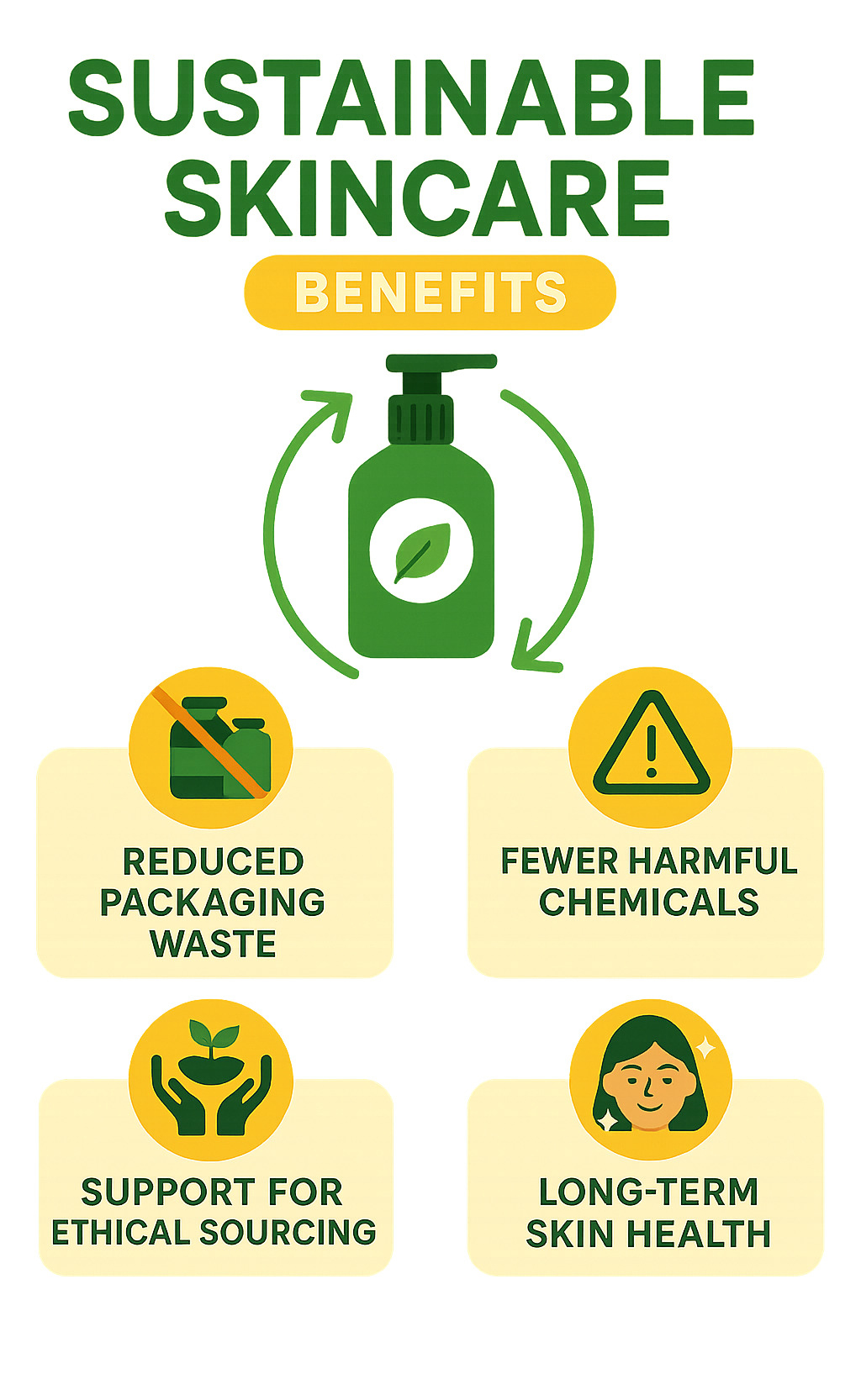
When you support these companies, you’re not just buying skincare – you’re voting for the kind of world you want to live in. You’re saying yes to fewer, better products that respect both your skin and the environment. You’re supporting circular packaging innovations that could revolutionize how we think about waste.
As you build your own sustainable routine, perfection isn’t the goal – progress is. Start by using up what you already have. Then gradually replace products with more sustainable alternatives as they run out. Choose products that do double duty when possible. Support brands with genuine certifications, not just pretty packaging.
The most beautiful thing about sustainable skincare is how it changes your relationship with beauty itself. Instead of constantly searching for the next miracle product, you start appreciating the simple pleasure of taking care of your skin with ingredients that also take care of the planet.
The future of skincare is sustainable, and it’s happening right now in bathrooms around the world. Every time you choose a refillable cleanser over a single-use bottle, every time you pick a multipurpose balm over three separate products, you’re part of a movement that’s proving beautiful skin health and a healthy planet can go hand in hand.
Ready to explore more sustainable beauty options? Check out our comprehensive guide to sustainable beauty products and join the growing community of conscious consumers who are rewriting the rules of beauty – one thoughtful choice at a time.

